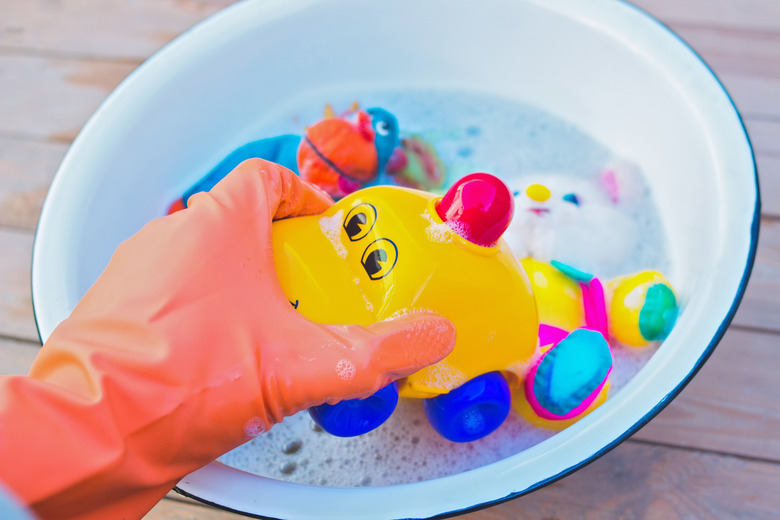Lead Exposure In The Home: Where Is It, And How Do You Deal With It?
We may receive a commission on purchases made from links.
The dangers of lead exposure have been understood for centuries, but regulatory agencies have been slow to regulate lead in the environment. Like asbestos, lead is an environmental health hazard precisely because it's so useful, and its ubiquity in and around the home increases the risk of lead poisoning. It may be found in paint, pottery and other ceramic objects as well as in children's toys and jewelry and even in imported foods and medicines. In homes with lead paint on the walls, it may be dispersed as household dust, and in homes served by lead water pipes and fixtures, it may be in the drinking water.
It wasn't until 1990 that countries began to ban the use of the additive tetraethyl lead (TEL) in gasoline; the United States didn't do it until 1996, and some countries continued to use leaded gasoline until 2014. The use of lead paint continued in the U.S. until 1970, and some 6 million lead pipes supplying water to municipal water systems are still in use in many parts of the country.
Because lead is still present in many products, it's important to know where to look if you want to protect your family — particularly children, who can develop neurological and nervous system issues — from lead contamination.
Tip
Lead can be in the air or on painted surfaces in your home as well as in soil and water and in imported toys, canned food and imported medicines. You can test for lead in paint, water and soil, and if you find high levels of lead, everyone who lives in the house should consult a health care provider and have blood tests.
Why Is Lead Exposure So Bad?
Why Is Lead Exposure So Bad?
Lead enters the body most frequently through ingestion or inhalation, and once inside, it's there for good. The body has no ability to metabolize, digest or purge it, so lead circulates through the blood into various organs, including the kidneys, muscles and brain, where it causes damage by interfering with enzymes inside blood cells and the cells of these organs. It can cause muscle and joint aches, constipation and fatigue. It decreases fertility and can be responsible for high blood pressure and anemia many years after exposure. After causing health problems like these and others, including persistent abdominal pain and weight loss, lead remains in the body and settles in the bones, where it remains unless reduced through chelation therapy.
The symptoms of lead poisoning in the brain and nervous system can be dramatic and horrifying. Shortly after General Motors began producing TEL as an antiknock additive for gasoline, workers at the factory began to have psychotic episodes, and the plant became known as "the house of butterflies" because they could be seen frequently brushing nonexistent insects off their arms. Lead interferes with the release of neurotransmitters and inhibits the function of a receptor vital for memory and making new neural connections.
Because of the cumulative effects of lead in the body and the likelihood of adverse health effects later in life, the Centers for Disease Control and Prevention (CDC) has stated that there is no safe blood level for lead in young children, although it allows anything below 5 micrograms (µg) per decaliter (dL) to be potentially safe. Besides all the symptoms of lead poisoning that adults experience, children can also experience behavioral problems, memory loss and learning difficulties. Pregnant women store lead in their bones along with calcium, and it can be passed to the fetus or to newly born children through milk and may cause birth defects or premature birth.
You Find Lead in the Strangest Places
You Find Lead in the Strangest Places
People throughout the ages have unintentionally ingested lead from water pipes, lead cookware and lead-based ceramic glazing and have suffered the consequences, but many others have intentionally ingested lead-based products. Because litharge has a mildly sweet taste, it was used to sweeten wine in the German city of Ulm in the Middle Ages until the city physician discovered it to be responsible for a colic epidemic, and it was banned. As recently as 1994, red oxide lead was added to paprika to brighten the color, and in 1982, the Los Angeles Department of Health Services discovered that two Mexican folk remedies, azarcon and greta, were lead tetroxide and lead oxide respectively and were the likely cause of death of a 3-year-old child who was treated with them.
People living in homes or apartments built before lead-based paint was banned in 1970 might be surprised to find that old coats of paint (often buried under several newer paint jobs) on the trim and baseboards contain lead, and this is a common hazard in older homes. If the paint should begin chipping or cracking and that bottom layer becomes exposed, a curious toddler could come in contact with it, or even worse, it could flake off or get rubbed off and end up flying through the air as lead dust to be inhaled by anyone nearby. Homeowners might also be surprised to discover that their shiny ceramic pottery and wall tiles contain lead, which is why they're so shiny. Lead-based pigments are some of the brightest.
Lead can also turn up in these unexpected places:
- In stained-glass windows. The solder often contains lead and even the glass if the window is old enough. The glass in antique cabinets and glassware is also frequently leaded.
- In folk medicines. Besides being an ingredient in azarcon and greta, it's also a component of many Ayurvedic remedies, especially the ones available online.
- In soil near old painted buildings or fences, which may be contaminated by lead paint chips. Soil near roadways may be contaminated by residue from leaded fuels.
- In food grown in contaminated soil. This is most common when vegetable gardens are planted close to old buildings with peeling paint or alongside well-used roadways. Some imported candy, such as tamarind from Mexico, may also contain lead as well as canned goods from countries that don't prohibit the use of lead solder for the cans.
- In toys and jewelry for young children, especially imported ones. The Consumer Product Safety Improvement Act signed in 2008 requires toys to be tested for lead, but products from other countries aren't necessarily as well regulated. Lead may be present in the paint as well as in metal and plastic parts.
Lead in the Water Supply
Lead in the Water Supply
The water crisis that unfolded in Flint, Michigan in 2014 alerted Americans to the severity of the problem of aging water supply systems. When the source of the city's drinking water was abruptly switched to the Flint River, making use of an outdated plumbing system as a cost-saving strategy, many people became sick. There are some 6 million lead service lines in the United States, but they aren't the only source of lead in drinking water. The solder used to connect the pipes may also contain lead, as might old metal faucets. Homes built before 1986 are most likely to have problems.
The Environmental Protection Agency warns that lead can enter the water when old lead-based pipes and fixtures corrode, and the rate at which this happens increases with high acidity, mineral content and the temperature of the water along with infrequent use, which allows water to remain in the pipes and absorb lead for longer periods. Anyone who suspects lead in the water should turn on the water frequently to keep it moving, and if tap water must be consumed, drink only cold water.
Protect Yourself From Lead Exposure
Protect Yourself From Lead Exposure
The greatest risk from lead exposure is impaired brain development, especially in children, but high lead exposure can also damage the kidneys and nervous systems of both children and adults, and extremely high levels can cause seizures, unconsciousness and death. It's important to take precautions to limit lead exposure, and some everyday measures you can take include:
- Wash children's toys regularly.
- Keep your home well-maintained and clean dusty surfaces frequently to reduce exposure to household dust that may contain lead.
- Remove your shoes indoors. This will limit the amount of lead-based soil you track into the house. This is especially important if you live in an older house that may have an exterior coat of lead-based paint. You should also discourage children from playing in the soil near the house.
- Run the tap for a minute before using the water. Use cold water only. If you need hot water for cooking or for tea, boil cold water on the stove.
- Eat foods that are rich in vitamin C and calcium, which may help prevent lead from being absorbed into the body.
Testing for Lead Exposure
Testing for Lead Exposure
The three most common sources of lead exposure in the home are lead-based paint, lead in the drinking water and lead in the soil. You can buy a kit at any hardware store to test for lead paint, but it will give you only a positive or negative result; it won't tell you how much lead there is in the paint and whether the concentration is dangerous. That's still important information, and it's easy to obtain. To use the kit, you carefully expose all the paint layers on a surface by scraping and then you apply the testing compound according to the instructions. It will change color (usually to red) if lead is present.
You can also test the water using a drinking water test kit, which will give you information about the presence of harmful bacteria and other minerals. This is especially useful information if you have a well. Like the test for lead in paint, the water test won't give you information about lead concentration; it will only confirm the presence of lead.
If either a surface or water test is positive, the best course of action is to collect another sample and send it to a lab for analysis. Kits are available that allow you to do this both for lead paint and for lead-contaminated water. It's more challenging to test soil at home, so most soil testing kits require you to collect a sample and send it to a lab for analysis. You can also use this type of kit to analyze paint chips as well as dust collected inside or outside the house.
Once you know the sources of lead exposure around the house and the amount of lead to which you have been exposed, you'll probably want to get a blood test for each member of the family to determine blood lead levels, and if they are above the CDC's limit of 5 µg/dL, you'll want to discuss remediation strategies with your health care provider. Quick action may prevent disease and debilitation several years down the road.
References
- Center for Biological Diversity: History of Lead Poisoning in the World
- Thomas Jefferson National Accelerator Facility: The Element Lead
- Centers for Disease Control and Prevention: Lead Poisoning from Mexican Folk Remedies — California
- The Conversation: Why Lead Is Dangerous, and the Damage It Does
- Mayo Clinic: Lead Poisoning
- Centers for Disease Control and Prevention: Lead Hazards in Some Holiday Toys and Toy Jewelry
- United States Environmental Protection Agency: Basic Information about Lead in Drinking Water
- California Department of Public Health: Testing Your Home for Lead


